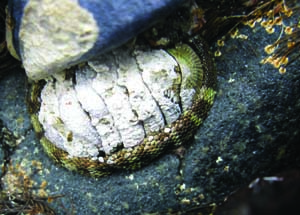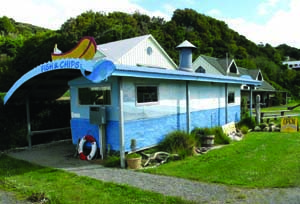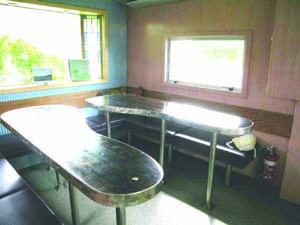|
Jackson’s Bay prides itself on being the remotest village on Earth. There isn’t much here of course: a jetty, a few houses, a lobster freezing plant [deserted], no shops, a beach shack; at the end of the village a wooden hut with the roof partly gone and a notice: Rarely available for sale, huge potential for development, street frontage, soughtafter area (6414 m2), with the name of an estate agent a great distance away... and of course some beaches with sea shells which is after all the point in going. There is also a memorial to the first, unsuccessful settlers of this wild coast. It is said that there were so many shipwrecks hereabouts at the end of the nineteenth century that they started making ship’s hulls out of reinforced concrete. To get here, start from Heathrow and fly as far as possible (Christchurch, New Zealand). Take a car and drive over the mountains to the west coast, then travel south until the road runs out. The original plan was to visit that lonely beach shack, called the Cray Pot, to sample what are supposed to be the world’s remotest fish-and-chips; but it wasn’t going to be my lucky day, the place was closed. So was everywhere else. Enquiries a couple of villages further up the coast revealed that the local search-and-rescue helicopter pilot had died, and the entire population had gone to pay their last respects. A footpath at the end of the harbour led through coastal bush to a pleasant rocky cove known as Ocean Beach which was well supplied with living and dead molluscs to study. This is about as far from modern living as you can get. Despite the remoteness, there was a signboard bearing a well illustrated poster with information about the steep cliffs made of breccia several million years old and the broad intertidal platform on which you can find barnacle drills, radiate and ornate limpets, snakeskin chitons, top shells, green chitons, catseye snails, blue mussels, common octopus, dark rock shells, green-lipped mussels, pauas and tiny snails, as well as hosts of other marine life. Most of these creatures were indeed there, live and crawling, but it was a disappointment not to have seen the octopus. My further intention was to visit Doubtful Sound in the road-free district known as Fiordland, but the weather turned very wet. One group who had managed to make the journey there said they had seen nothing but rain, mist and a few half-discerned cliff faces. Not such a good idea then. So headed back across the mountains and southwards to visit Stewart Island instead. At the southern tip of South Island at Stirling Point, after negotiating the Fairy Chicken Disk [this is pure Bluff: where you buy the boat tickets!] I boarded a wide singledeck enclosed catamaran and headed at 22 knots across the seriously corrugated seas of the Foveaux Strait to Oban Harbour in Half Moon Bay. Some very pleasant tree fuchsia woodland was found just beyond the harbour where many birds were sampling the nectar; I had a very good sighting of the woodland parrot known as kaka in Maori, and then took the opportunity to hunt for molluscs on three beaches. One of the streets on the way back had what appeared to be a large mobile home parked in it; but it was in fact a fish-and chip restaurant on the point of opening for the late afternoon. In conversation with the proprietor, expressed disappointment at not being able to eat at the Cray Pot; whereupon she produced a photograph of the said establishment and then claimed that it was her restaurant instead that was the remotest on earth! She then said, have a look in our dining area at the other end of the caravan and see the sea shells that we have embedded in resin in the table tops! So I did. There were some very colourful examples of the extremely variable fan shell Talochlamys zelandiae, the wheel shell Zethalia zelandica, and two differently sized specimens of the ambiguous trophon Xymene ambiguus. Just before boarding the catamaran for the much smoother return voyage, overheard a conversation to the effect that that the island had completely run out of petrol, to the consternation of the water taxi operators. Such are the perils of living in remote areas. |
Illustrations by A S Naylor
|
Sea shells at the end of the Universe
Issue
21
Page
27

 Figure 1 Austrolittorina antipodarum at Ocean Beach
Figure 1 Austrolittorina antipodarum at Ocean Beach Figure 2 Ringaringa Bay on Stewart Island
Figure 2 Ringaringa Bay on Stewart Island Figure 3 Callochiton pelliserpentis at Ringaringa Bay
Figure 3 Callochiton pelliserpentis at Ringaringa Bay Figure 4 Kai Kart fish and chip restaurant on Stewart Island
Figure 4 Kai Kart fish and chip restaurant on Stewart Island Figure 5 Dining area in Kai Kart fish and chip restaurant
Figure 5 Dining area in Kai Kart fish and chip restaurant Figure 6 Talochlamys zelandiae shells inset in table in Kai Kart fish and chip restaurant
Figure 6 Talochlamys zelandiae shells inset in table in Kai Kart fish and chip restaurant